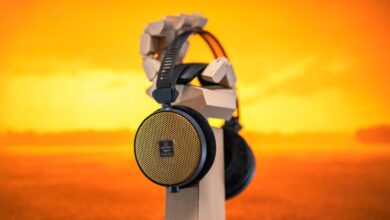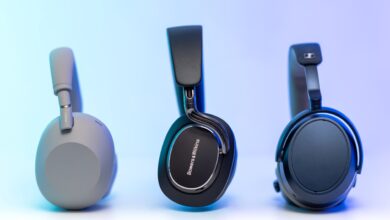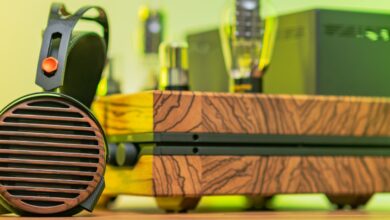Meze RAI Penta Review – Easy Rider

My Video Review:
It was October 2017 when I’ve had a secret meeting with Paul and Mircea of Meze Audio. I and a handful of people would be meeting for first time those extremely sexy looking Empyrean headphones. Sure enough, at that time rumor mill was spinning in full-force and the chu-chu hype train was all over the place, people were beginning to suspect that Meze is working on a planar-magnetic headphone and the pressure put on the Meze Audio team was unreal…such exciting times for us, headphone listeners. We’ve seen how they looked; we were literally stunned by their looks! We touched them are we almost licked them too. We learned why they chose an oval shaped driver, why going planar-magnetic, the advantages of using hybrid array drivers, the challenges they faced while designing that CNC machined chassis and interesting looking grilles and many other things.
I’ve learned quite a lot about their huge and long roadmap, about their new ideas that wheels of times already put into action. Probably the most unusual thing to learn was a secret development of their first ever five driver IEMs that didn’t have a name, yet. We’ve seen the sketches, we talked about drivers, cross-overs and about a fine tuning that needs to be done to strike a perfect balance between sweet harmonics and critical precision. With a pair of Meze 99 Classics around my neck and with 99 NEO around the corner ready to be released, it was like seeing your favorite TV show two years before it goes live! We were anxious to know more and Meze team was excited to know our feedback.

I’m going to confess that besides Audeze and Kennerton headphones, I was always fascinated by the looks of all Meze Audio headphones. They are looking unlike anything on the market. I’ve said it before that brand identity is very important in such businesses, because it spreads the word by itself, it works like free marketing. If I’m able to identify a brand of headphones from afar, then they achieved their goals and the brand image will be spread like sweet pollen for the bees. It doesn’t come as a surprise when the main soul behind the show is a hardcore designer at heart, just look at those Empyrean and at 99 Classics – with smooth clean lines, perfectly balanced looks, with a nice blend between looks, materials and comfort levels. The shape and clean lines of the IEMs that I will be testing today, are exactly that kind of music making engines. You can’t unsee the bright looking harp resting on a matte black surface, they simply scream Meze Audio from afar and that is a very good thing in my book. RAI Penta is currently their flagship IEMs and their name is a simple play between two words. RAI stands for Heaven in my mother tongue and Penta for five drivers, so let’s dive deep, listen & measure them and leave a ton of sound impressions.

Unboxing Experience
RAI Penta are coming in a fairly large matte black box with a wavy design pattern. This is currently the biggest IEM box I’ve received so far, so I expect a fair number of accessories inside. On its back you can see an exploded view of the IEMs with their inner workings, including their drivers and main specs.

Package Contents
After opening the box, I was greeted by the IEMs themselves with a really nice matte black body which wasn’t too small, nor too big, just the right size for my ears. This is my favorite color; I truly like their stealthy look that would not attract a lot of attention while jogging outside. The smooth lines carved in an aluminum shell is again reminding me that I am dealing with a Meze made IEM.
Penta’s are coming with a sturdy 4-wire Silver Plated Copper litz cable. I particularly like the metal housing of the splitter and on the 3.5mm end, it is a high-quality cable that should resist a decent amount of stress. It is really flexible too, but it’s not all over the place like some Chi-Fi IEMs are having, it will not entangle itself so easily in the pocket. I see that it is Rhodium plated on both ends, it reminds me quite a lot about high-end Futurech jacks. Rhodium is harder than both silver and gold and it will form an excellent protective coat that will shield away those MMCX and 3.5mm connectors from scratches and oxidation. If you need an extra balanced 2.5mm or 4.4mm cable, Meze is offering those at $149 with the same braided design, using only silver-plated copper litz wires.
Just below the IEMs, you can spot a hard case with a metal logo in the middle, it is a decent quality case, nothing more and nothing less. Inside it you can find some extra accessories like a cleaning tool, an airplane 2 pin adapter, a headphone adapter to connect them to your desktop gear and that is it.
RAI Penta are also coming with 8 pairs of ear-tips split in 4 categories, as follows:
- Balanced ear-tips (4 pairs of XS, S, M and L sizes), these are the standard soft silicone tips. In my experience these worked decent for me, but didn’t have the best isolation
- A pair of Bi-Flange ear-tips. Etymotic users know them very well. Sadly, they don’t work well for me, my ear-holes are not that large (Yet!) Insert at your own risk.
- Two pairs of Deep insertion Bi-Flanged ear-tips. These should be inserted even deeper for a good seal. Surprisingly these worked better for me, mostly because they have a smaller diameter so it’s much easier to insert. They have a great seal meaning that bass performance should be improved.
- pair of Comply Foam ear-tips. Here’s a free tip on how to improve your RAI Penta: detach the stock silicone ear-tips, insert the Comply ones and that’s it! Your RAI Penta’s will be performing at their maximum potential. These are by far the most comfortable ear-tips with the best seal and the best bass performance.
I would exchange that single fat Bi-Flange ear-tip with another set of Comply, I simply love them.

Build Quality & Looks
Their shell is sculpted from a single aluminum nugget on a CNC machine. It’s a very tedious and time-consuming process, but the end result speaks volumes. Simply put, these are one of the nicest IEM bodies I ever played with. They look perfect to me and their shape fits like a glove for my ears, they are much comfier compared to FiiO offerings for example. Their anodized texture makes them less slippery compared to electro-painted or resin bodies, so they will stay put and will not fell off that easy.
I like their size the most, these are fairly small, much smaller in size compared to multi-driver Chi-Fi options like KZ AS16, they have a smaller body compared to other 5-driver IEMs like FiiO FH7 for example, they are putting a smaller pressure on the ear cavity and after jogging for two hours outside, I didn’t feel any discomfort as I’m feeling with other multi-driver IEMs.
The outer nozzle is having a diameter of about 5 mm – it is the standard sized one, so you can easily use your growing ear-tip collection. The nozzle depth is at about 5mm in length, so again lots of Comply, Spin-Fit and other ear-tip brands will work with these no problem. The MMCX connector is buried in the shell and doesn’t stick out too much. I like that you need to apply quite some force to attach and detach the cable. Meze doesn’t have a long history of using MMCX connectors, but I feel that they started with their right foot on this one. The cable stays sturdy and doesn’t wobble in the MMCX socket at all, which is a very good sign.

Tech Inside RAI Penta
As their name suggests, Meze put five drivers in these to cover a wider range in the frequency response. They have two armature drivers for midrange, Meze is calling them Presence and Human Voices, another two armature drivers for treble – Brilliance and Beyond Brilliance according to Meze. A huge dynamic driver is all about that bass, or Rhythm Frequencies according to its creators.
Of course, there is a custom cross-over design that will make all those 5 drivers working harmoniously together as a team. Unfortunately, we don’t know the maker of those armature drivers, so I can’t comment on those, but considering their price point, I’m pretty sure those are high-performance drivers specifically tailored for high-end audio listening on the go.
Meze put three sound tubes with a three-bore design, each one will carry your bass, midrange and treble acoustic waves directly into your ears. RAI Penta covers a really wide frequency response of 4 Hz – 45 kHz, it is much wider than our hearing abilities, but I will make sure to measure them soon, including their FR and I’m quite curious about the outcome.
When Sennheiser released their first-generation IE800 IEMs many years ago, they put two small holes on its body, that would move the air pressure out of the IEM body and in between your ear canal. They shook the world and every other IEM maker watched silently, taking notes. Nowadays, this simple but very effective trick is improving the comfort level of the listener since the air pressure in the ear canal is much lower and the unwanted acoustic waves around the drivers are moved outside their bodies for a lower total-harmonic-distortion. Meze is calling their version Pressure Equalization System or PES for short that does exactly that. Since small portions of air will leak outside, even when not listening to music, it makes them a sort of semi-open IEMs improving their soundstaging capabilities.
With an impedance of just 20 Ohms and with a high sensitivity of 110 dB per one single mW of power, you can drive these with pretty much anything that has a headphone jack. Obviously, at this caliber, I would use only high-quality sources that could provide a healthier amount of current and voltage. Make sure to use a dead silent portable DAP as they are quite prone to noise from the source. A really nice pairing was with the FiiO’s M11 PRO carrying dead-silent THX AAA modules that worked as magic with them.

Sound Performance
I. Preliminary Impressions
The absolute first thing that hit me was a beautiful lush midrange that added a lot of warmth and rich natural harmonics in my music. Mid-bass was really bold and fleshy, it was always here with me, it was a thumping type of bass, instead of a speedier one. Both the mid-bass and the midrange were very textured, very outlined and present, they took a step forward and all the microphones were directed towards them. While listening to acoustic music, where tens of instruments are competing for prime time, all that amalgam sounded very real, it was a much fuller and a much denser type of performance. It was like a NOS vacuum tube or a class-A output stage was planted inside my Benchmark HPA4 without my consent. From lean and boring Chi-Fi IEMs, RAI Penta were on the opposite team, by sounding alive, with a lot of meat to the bone, pushing bigger amounts of air in a smooth and relaxed fashion. Voices were simply to die for, as any vocal performance sounded like whispering directly into my soul.
Way Down Deep by Jennifer Warnes (Tidal / Spotify) sent shivers through my spine, the thumping bass notes and those voices playing with my imagination made me close my eyes and be part of that music and from a 10th row like it was on Empyrean, I’ve felt like I was on the 5th row, where every artist came closer to me and started playing only for me.
Wait a minute… did I just describe the sound of their Empyrean headphones, didn’t I? Well, that is actually correct and I’m not sure how Meze did it, but the little RAI Penta is the embodiment of their Empyrean headphones in a very small and compact body, which you can carry around with you and drive with basically anything that has a headphone jack. I’m spotting exactly the same inoffensive and lush sounding headphone that cares more about the holy act of music listening, completely disconnecting you from the real world, than about counting how many imperfections this song has or how many times a car passes by the recording studio.
Meze RAI Penta is definitely about simpler things, about the music and emotions and considerably less about technicalities and small nuances. It is about the bigger picture and not about the sum of all things…Slowly but steadily, I started to understand them, music is obviously not only about transient response and high amount of details, it is also about being gentle and smooth and having a good balance between being natural and precise sounding.
I’ll be honest with you, RAI Penta didn’t won me over in the first few hours, I was still searching for body hits, viscerally and for a faster pace, but when I switched to some acoustic music, blues and jazz, I finally understood them and I see why one would want to listen to these instead of an IEM that puts you between the hammer and the anvil.
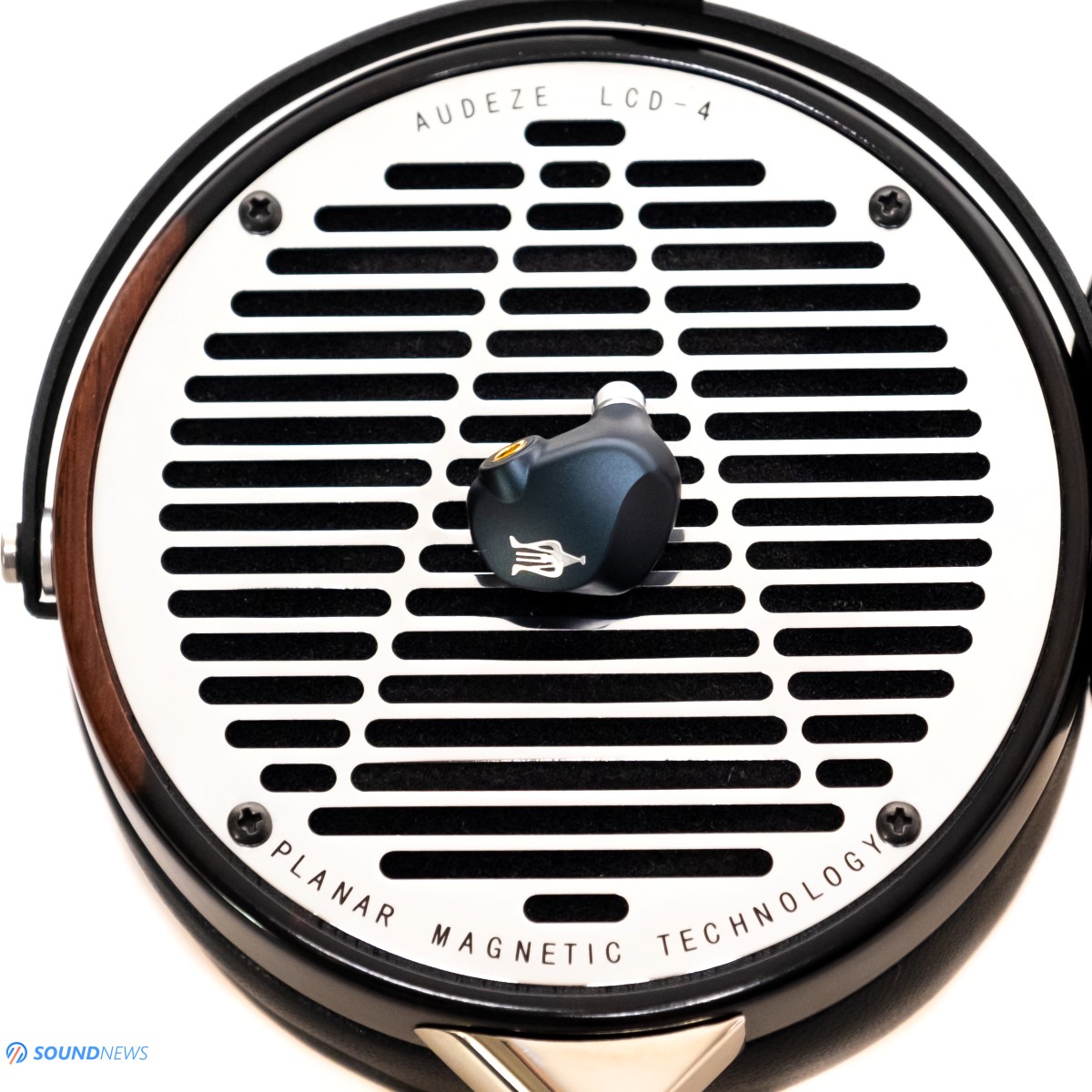
II. Transient Response
Generally speaking, hybrid IEMs are not the absolute rulers in terms of speed. Due to a bigger diaphragm that moves air around, hybrids will impress you more with their sheer slam and body hits, creating believable bass notes with layers and sub-layers of bass hitting one after another. Hybrids are more about the muscle mass, than about being ripped and slim fit. RAI Penta is definitely a hybrid IEM, they will not win you over with their incisiveness, they don’t have a need for speed so to speak, they will charm you more with natural decays and impactful body hits, especially in the mid-bass and midrange section. Transient response can be defined is a sum of two important things: speed of delivery and slam that follows. Thanks to its longer natural decays, I can’t call it being perfect in terms of transient response, for that a speedier pace and execution will be needed. Don’t you worry thought, Meze is one of the youngest teams in the business, they learn and they learn fast and I’m sure their next iteration would be better at pressing the gas pedal.
While listening to fast executed tracks like Spitfire by Infected Mushroom (Tidal / Spotify), I did receive a fair share of impact and bass slam. They didn’t lack at all in the mid-bass region, but I wanted just a smidge more in the lower-end. I don’t consider the sub-bass recessed or shy sounding, it is anything like that, it is that mid-bass receives more attention from the listener, it is the King of the hill when it comes to frequency response and when that happens everything else simply runs a meter behind it. Sub-bass is there too and it will suffice, but it didn’t feel as visceral and as impactful as the mid-bass was. This track has a lot of small details put here and there and everywhere in the song, if you are not familiar with them you might miss them, luckily most of them are playing in the mid-bass to midrange region where RAI Penta feels extremely cocky and powerful.
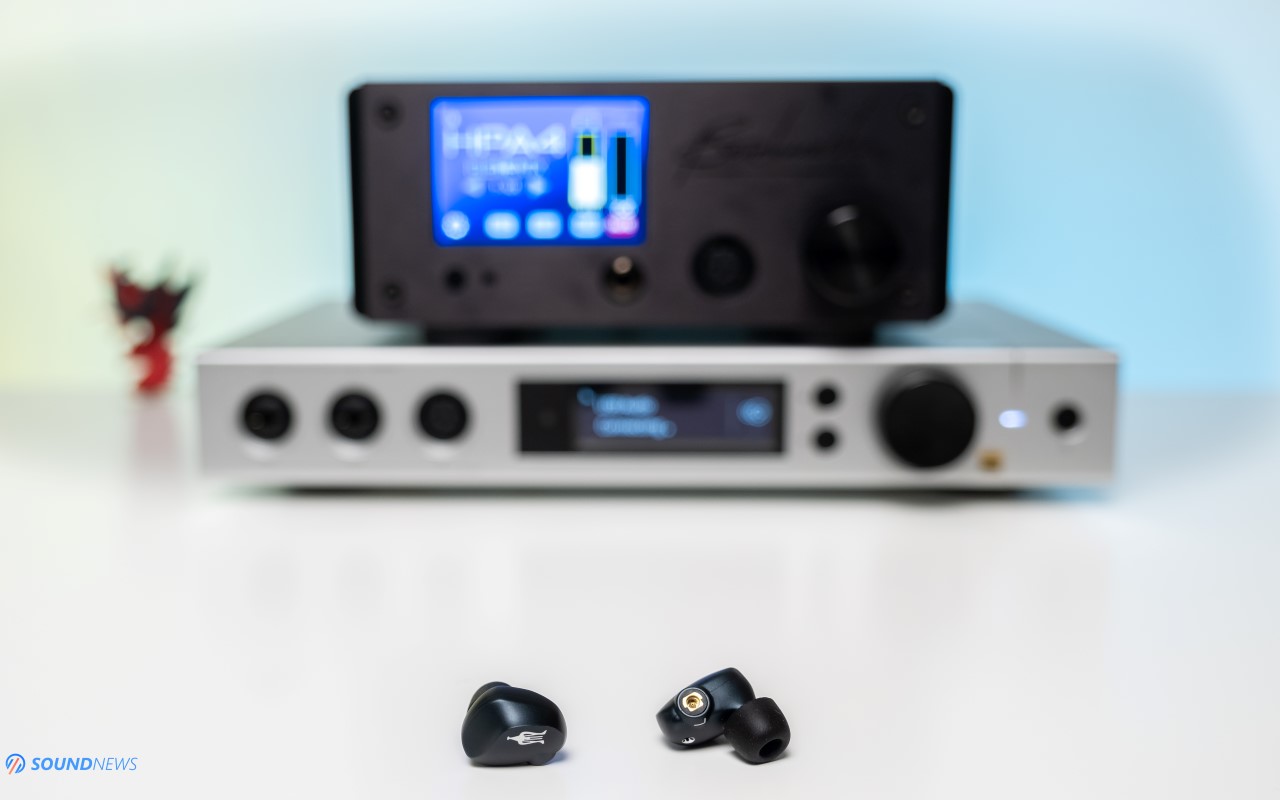
III. Portable VS Desktop power
I want to outline how different these sounded on portable devices compared to desktop Hi-Fi setups. They sounded extremely good out of a FiiO M11 PRO and M15 DAP, even on the single ended jack they were offering almost everything I wanted.
When I came home and connected them to a Benchmark HPA4, they changed quite a lot in a good way (at least for me). Their speed improved so much that it almost makes me re-write my previous chapter. With the Little Dot MKIII SE they hit the brakes with a slower presentation and the same can be said about that xDuoo TA-30 that pumped more midrange presence in these but made them slower to a point that I liked them more out of portable devices.
By far, the fastest and most impactful pairing was with a Benchmark HPA4 that shook those drivers pretty hard, awaking crazier dynamics with much wilder dynamic swings – I must add, this was an outstanding combo. Bass notes were snappier this time around, viscerally came back and from a smooth easy rider, Penta became an aggressive rider competing for faster lap times.
As you can see, you can alter their personality quite a lot, they responded immediately with an amp swap and the same happened when I was exchanging digital sources. All of this tells me that Rai Penta is a pretty detailed and transparent sounding IEM that could be tailored to your sound preference.

IV. Soundstage & Depth
Considering we are talking about an earphone that stays few millimeters away from your eardrums, I can’t possibly mention about a nice depth or about notes flying around my head, or can I? I’m not really sure, if it’s the PES system that Meze developed, or the driver count, or that dynamic driver that pushes higher air quantities or the Comply foam tips, but RAI Penta are not sounding inside my head at all and they could easily start a fight with wide sounding IEMs. Soundstage is of course less extended left to right compared to a fully open-back design like Empyrean, but they are not that far off if you ask me. On Empyrean everything happens about a meter away from me – depending on the track of course, some songs might sound closer or farther away. Hoodoo Man Blues (Tidal / Spotify) with its extremely left to right soundstage sounded more like on the shoulder level compared to a stretched hand away on Empyrean, not a huge difference by any means but it was perceptible. To me, RAI Penta are easily sounding as open and wide compared to my other multi-driver IEMs like FiiO FH7 or FA9 and that comes as a small compliment for them.
That blues album is a very good example of completely disconnecting the right channel from the left, it sounds weird and far away at first, but the more I listen to it – the more I appreciate such a spread-out presentation. RAI Penta will easily show what is exactly happening on the far left and right and much less in the middle in front of me.
If you’d like to have a deeper or even a wider presentation than this, it can be easily achieved, but you will need a balanced cable and a balanced amplifier with a close to zero channel crosstalk. It is so happening that I have a dozen of balanced amplifiers around me, some of them work decently, some really well and as far as IEM pairing go, I would pick the Benchmark HPA4 and Topping A90 as the best units I’ve tried so far with these. With a close to zero channel crosstalk, it is like listening to Hoodoo Man Blues with absolutely every other track, everything starts happening more to my right and more on my left, the whole picture is increasing in size, I’m taking a step back and I’m looking at this beautiful, colored and detailed picture in front of me, where everything is tighter sounding and more outlined too. That’s right folks, even tiny IEMs inserted deep into your ear canal can sound big and spread-out and RAI Penta can do that with the right setup and music selection.

V. Detail Retrieval & Transparency
This is yet another interesting chapter that I want to cover. All in all, the upper treble response is a bit rolled-off, especially the upper treble is less piercing and will carry less sharpness and leading edge that will make you think Penta are less detailed sounding IEMs. Increasing the treble presence is actually a very clever design decision that a lot of manufacturers are using, especially top offering from Germany will make you feel that there is more information or detail in your tunes. Rai Penta is not like that, there isn’t a fake sharpness filter applied, it will not attract the attention of the listener in this region.
When developing a passive cross-over like the one inside Meze’s creation, it is a really difficult task balancing the frequency response and the timing errors of every driver to work in harmony. Treble is really hard to balance, especially when you want it less brittle and spicy, but still maintaining a higher degree of detail. With Penta, I’ve spotting pulsating bass notes, I’m feeling lots of layers and sub-layers of bass in my favorite electronica tracks. I’m spotting these pretty easily and I don’t even need to close to my eyes for that to happen. What I want to outline is that, RAI Penta is a detailed and quite a transparent sounding IEM, I can’t really compare it to other IEMs past the $1K barrier because I don’t have such IEMs anymore, but I can say that I am spotting more details compared to mid-range IEMs. With all that said, Penta doesn’t really want to transform your music into a big magnifying glass where every single note has a sharpness filter applied to it. Penta is rounding the outlines of your music; it makes it less raw and more refined. Leading edges are less defined but the sound is more textured and much fuller on the inside.

VI. Frequency Response
The frequency response of RAI Penta can be summarized as quite linear in the low and mid section and a bit uneven in the treble where there is a spike and a roll-off past top octave for a smoother rendition of the treble. I don’t hear anything standing out too much, maybe the mid-bass and midrange but only by a little to infuse more naturalness in here and shoo away some of that nasty brightness.
A. Bass
Sub-bass is really good in here and after trying some electronica tracks that I know for a lifetime, it’s clear that Penta is not suffering with bass roll-off at all. Now, there are few IEMs that are putting a bigger accent on the sub-bass performance than on the mid-bass, FiiO FH7 is a very good example and that works really well with modern music. The downside is that every other musical genre feels drier and thinner in the mid-bass, less impressive in the long run. Meze team decided to have a completely linear bass performance, it is a sleeper type of bass, that will impress you more in a day or two and not immediately. These are not your bass-canon headphones that will alter its tonal balance to unrecognizable, Penta’s are much closer to my linearity curve, having an even low-end that has a right amount of quantity and quality in the same chassis. Penta has one of the nicest bass performances I’ve heard in am IEM, it is extended, precise and very linear. The only thing I would want is a bigger ear-drum impact and a speedier pace, everything else is top notch.
B. Midrange
I’m very much a midrange addict, there is a reason I’m listening to a pair of Audeze LCD-4 on a daily basis. Most of the acoustic instruments and voices are happening exactly in this audible range. You can have a half-decent bass or treble performance in a headphone, but you should never play dangerous games with midrange performance, as once you lower it down, everything will sound off, thin, boring or plain lifeless. I’m not a “V-Shape” loving person and I don’t understand why someone would love that; it is like listening to fake music.
This is where Meze always stood out, it’s their coup de grâce and RAI Penta feels no different. If you really love your Empyreans for their life-like midrange rendition, then most probably the little RAI Penta is its closest relative sound wise. The same bolder, heavier and richer tone can be felt in here too. Midrange is excellent and there is nothing more to say about it. It is smooth, it is guttural with male voices and very exciting with female voices, it always grabs your attention no matter the song. The spot lights are always shining in this direction and that is actually a very good thing in my book. I can’t imagine listening to my jazz and blues with less midrange presence. Yes, it is by a hair more outlined, making half a step forward, but it is for the best since it will preserve natural tones of your music. I still want a contrabass to sound like one and not like a bass guitar. I don’t want male voices sounding like Conchita Wurst, I want them sounding like Leonard Cohen, if you know what I mean…
C. Treble
Treble is quite an interesting creature. It starts strong and there is plenty of it. It sounds clean, detailed and textured. The most sensitive part of our hearing is extremely well defined. It sometimes comes in higher quantities than I asked for, suggesting that there is a very small peak in here somewhere. Mind you, it is not bright sounding at all, more on the contrary. Past top octave (12 kHz), it drops smoothly and gently, there are still few sounds in there but their intensity is decreased. Cymbal crashes have shorter lives so to speak and will not hurt a treble sensitive person. I personally dislike bright treble and I can’t find anything like that in here. It has a right dose of details and highlights but it doesn’t tilt towards over-sharpness and shrillness. The upper registers seem to have a gentle roll-off, somehow making even bright recordings very manageable and less bothersome if you will. If your acoustic chain is a bit hotter sounding up-top, Penta could solve that issue without any changes to your hardware setup.
RAI Penta is mostly an easy rider that doesn’t want to stress you, on the contrary to relax you from a busy day. Very much like their bigger more expensive brother Empyrean, RAI Penta is slowly walking on the same path, by cherishing naturalness and midrange presence above anything else.

VII. Measurements
After offering my full-blown subjective opinion, it is time to put them under a magnifying glass and see how they perform. When it comes to measurements, my best friend is still the Benchmark HPA4 as it is as linear as headphone amplifiers could go and I used both the Matrix Element X and the Audiobyte HydraVox as the main DACs. The measurement rig was the MiniDSP EARS calibrated with IDF (IEM Diffuse Field) compensation files. Do note that MiniDSP EARS is not following any IEC standards, meaning that my readings can’t be used as reference measurements, I’m doing them just to get a general idea about their results and sound signature.
I’ve measured them only by using the Comply ear-tips as all other ear-tips would not offer a perfect seal, completely destroying the bass performance. I’ve measured them more than 15 times as finding a perfect fit and a complete seal was quite a challenge.

Here are their RAW measurements and as you can see the driver matching is good, the small 1 to 2 dB deviation is happening thanks their positioning on the test rig, I can easily make the left channel by 2 dB louder too.

Applying a ½ smoothing not a lot is changing. As you can see their bass and midrange performance is absolutely phenomenal and it looks like a straight line from sub-bass to upper midrange. Treble performance is a bit uneven, but that happens with all headphones not only with these. There is a bit more presence at 6 kHz that adds texture and more detail in here and past 12 kHz there is a slow roll-off that will make them smoother and gentler sounding.
As you can see, RAI Penta was tuned towards a natural and smooth experience, in detriment of a super-snappy and extended in the FR. I’m Ok with that, as besides analyzing my music when I’m doing reviews, immediately after I just want to relax and be carried away by it.
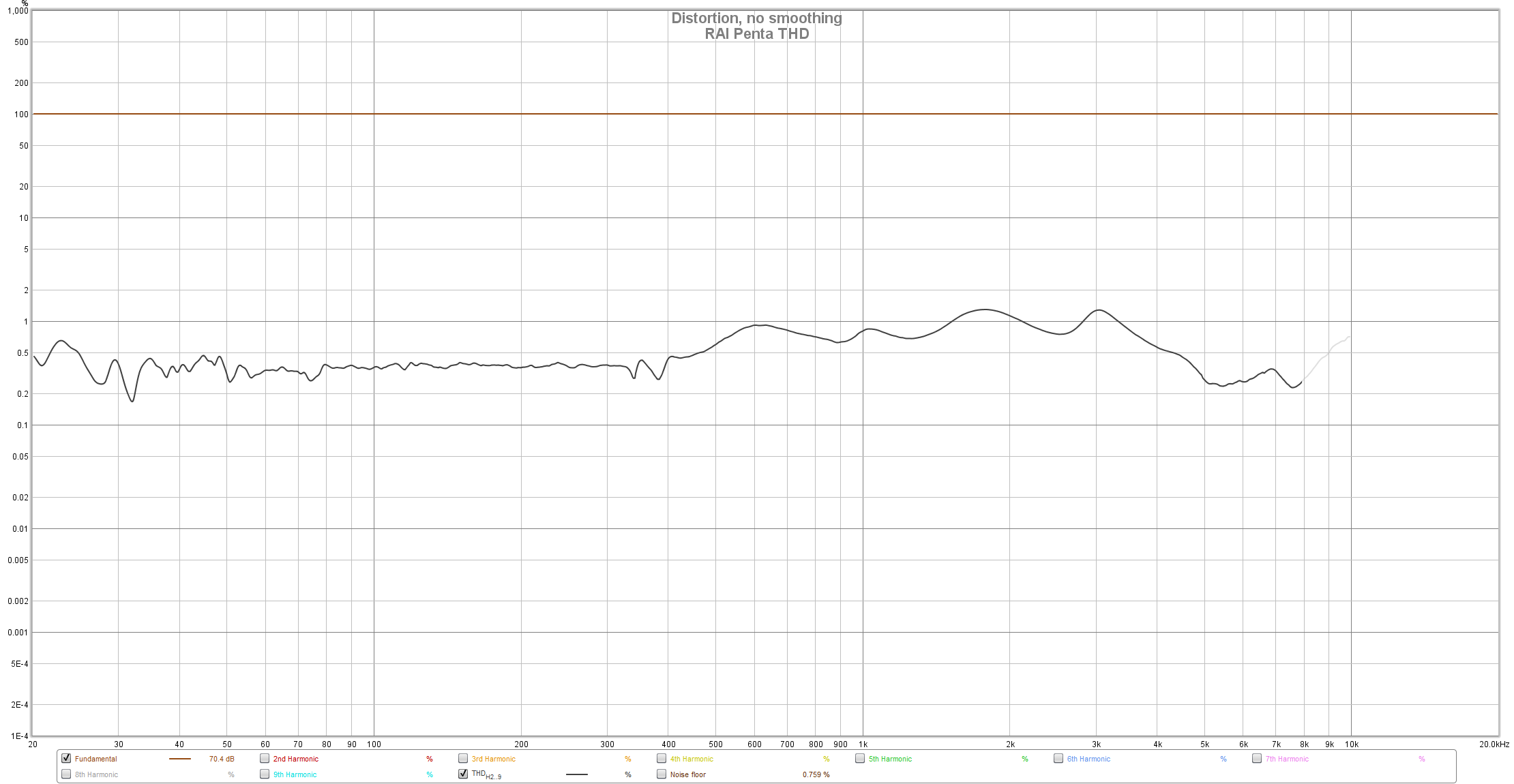
Their Total Harmonic Distortion (THD) reading is very good, I’m actually surprised that its dynamic driver never goes past 0.5% of THD even when feeding a strong 85dB signal. Treble sometimes touches that 1% of distortion, but it is far from worrisome and more than good performing in here. All past IEMs I’ve measured before were worse or much worse in terms of THD, so thumbs up Meze!
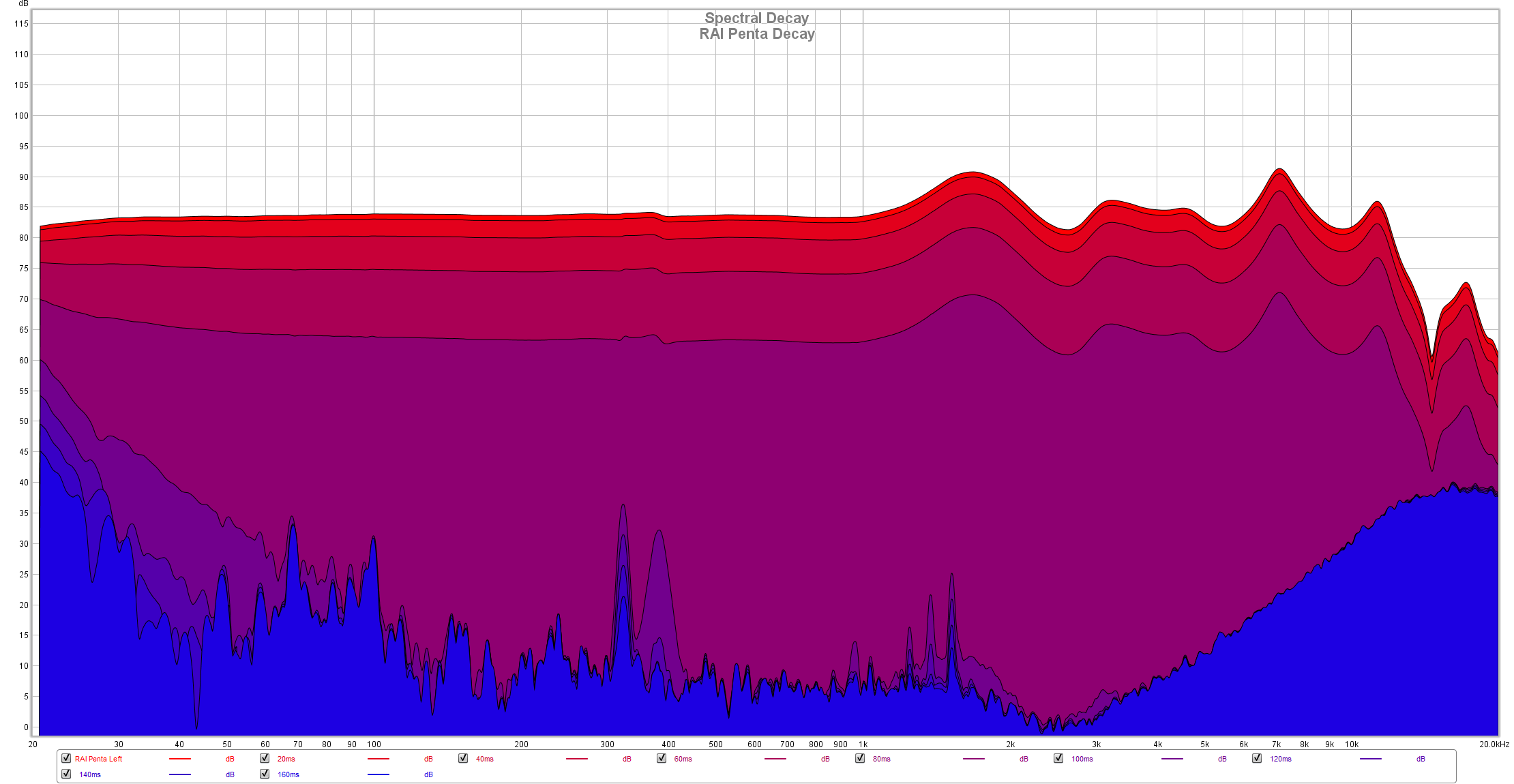
Its spectral decay is absolutely perfect and it simply outperformed all other dynamic, hybrid or balanced armature-based IEMs I have ever measured, their performance in here is much closer to planar-magnetic headphones. See how fast the sounds are decaying after just 160ms? These are some fast moving drivers. It is really a surprise for me, as my subjective opinion was a bit different.
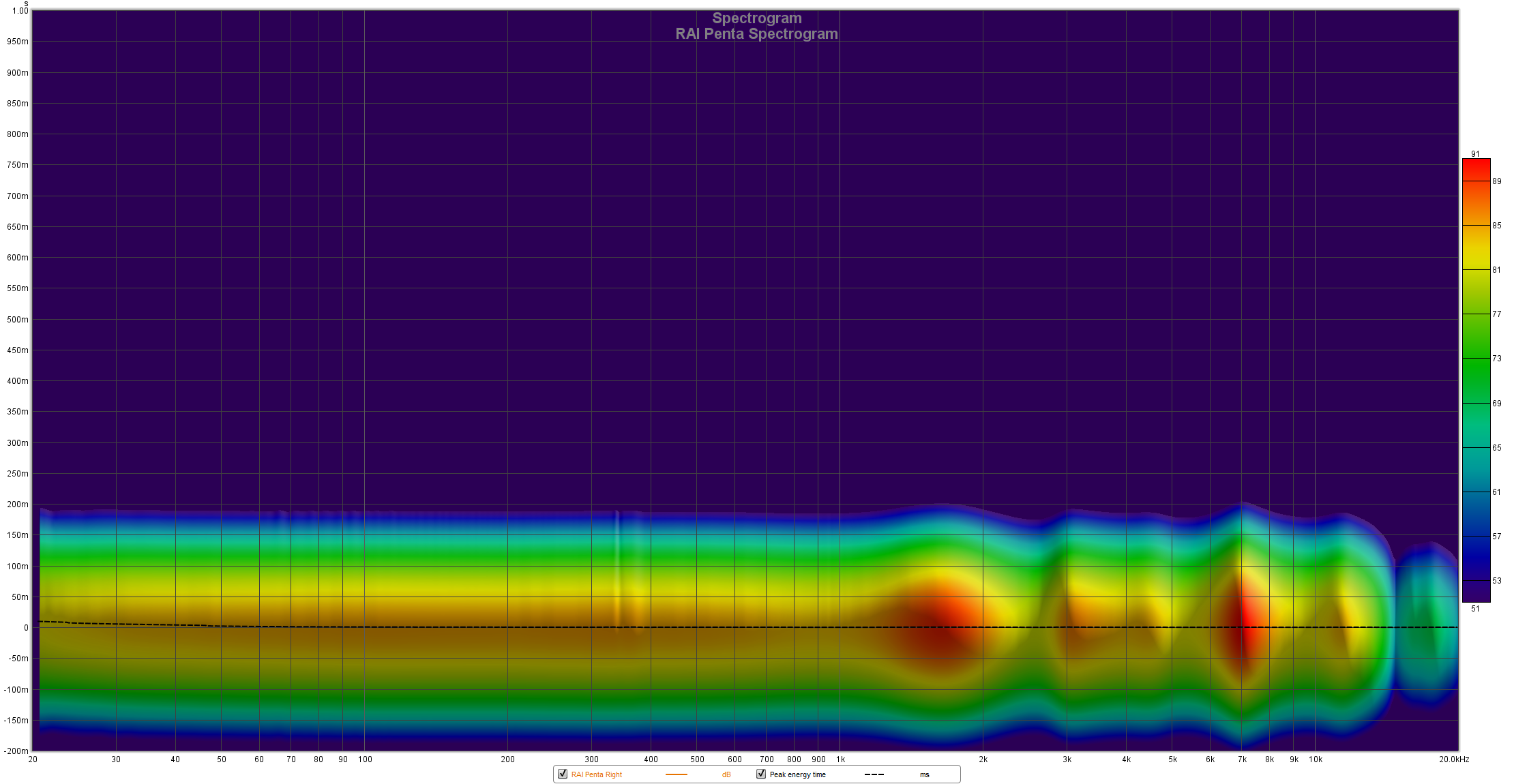
Spectrogram and waterfall are looking amazing too, there isn’t any grain showing in those readings, meaning that RAI Penta has minimal driver ringing across all FR range.
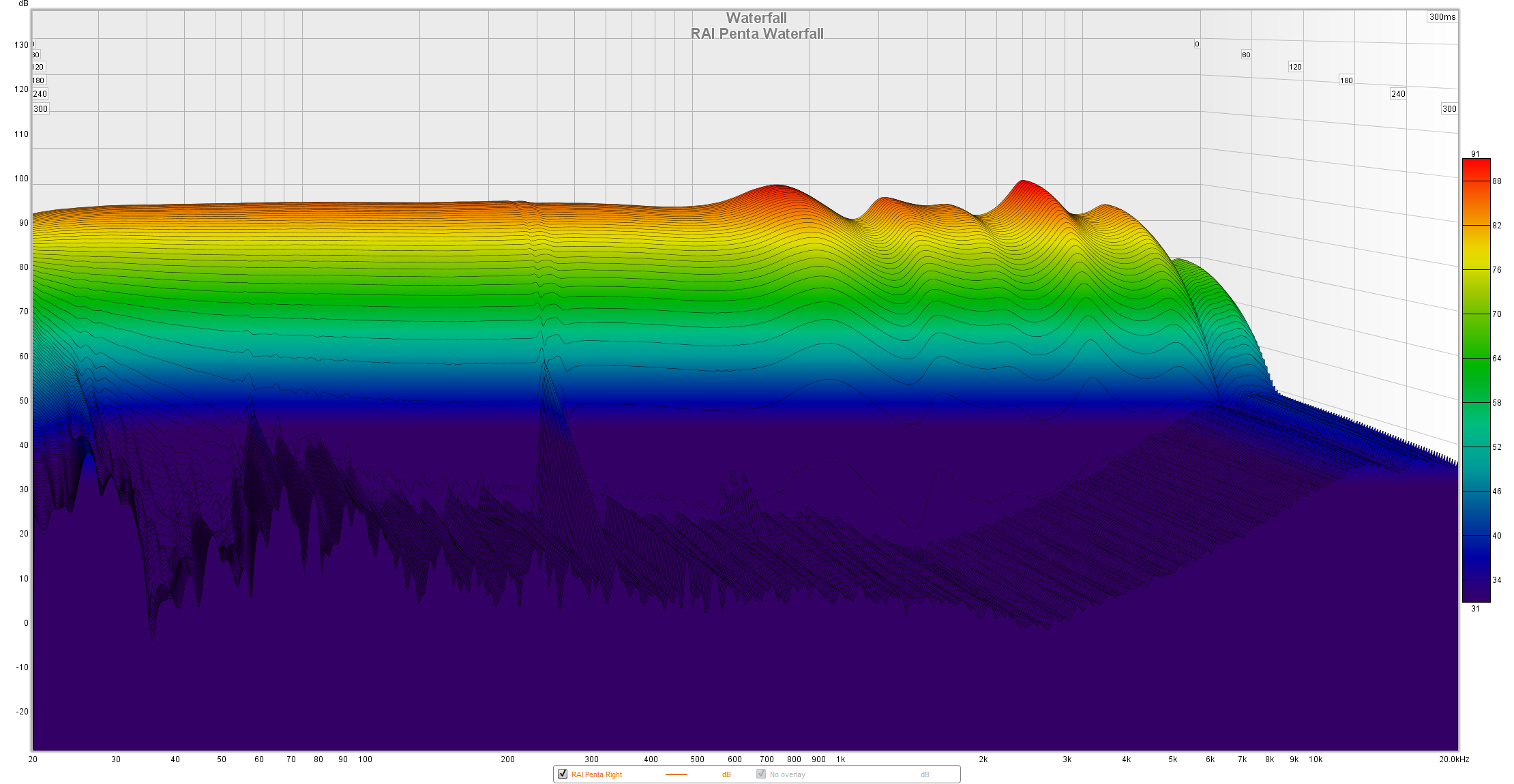
Overall, I’ve recorded a close to perfect frequency response that is impressively linear and extended, an incredibly low THD and the best spectral decay and waterfall reading I’ve recorded so far.
VIII. Comparisons
I will mention again that at this point I don’t own, nor do I have for loan and IEM in the same price bracket, so I will be comparing them with what I have around me.

Meze RAI Penta ($1099) VS FiiO FH7 ($449)
This is a comparison that a lot of my close friends requested, they all own the FH7 and are very curious about the RAI Penta. FH7 can be considered as my daily driver IEM, because there are a lot of things I like about them, which I’ll mention in a sec.
First and foremost, FH7 are also hybrid IEMs with the same driver count, their shell is also milled from a CNC machine. Build quality wise, FH7 are very close to the Penta, I only dislike their bigger shell that puts a bigger pressure on my ear cavity and their electro-painted body that is more slippery than the anodized coating on Penta. Romanian made IEMs are considerably more comfortable and will also stay put and will not wobble around compared to FiiO’s creation.
Accessories wise, I will give a slight edge to the FiiO, because they have few additional ear-tips that I really like (Spin Fit) and in addition a small fabric carry case which I’m using in short trips. Up to this point, these are more alike than different, so far FiiO is winning the accessories battle and Meze is winning the comfort battle by quite a long shot.
Sound wise, FH7 have a lot more going in the sub-bass region, in the top-octave and much less in the midrange section. These two felt like watching Batman V Superman for the second time, they have completely opposite sound tunings. FH7 impresses immediately as there is more sub-bass and more adrenaline rushes instantly. A better sub-bass equals with a better thump in the ear-drums, so electronic music feels extra snappy, engaging and really hard hitting. Sometimes it’s too much, especially with those memory foam ear-tips it is like being hit with a bass hammer. FH7 are also adding a lot of presence past top-octave, to a point that sometimes they appear as bright and harsh sounding by a little. Connect them to a neutral or bright sounding setup and these might get hot in the treble way too soon and way too fast. I like my trebles extended, I want clear cymbals and FH7 covers that in spades…it can become a little over the top, but on rare occasions. I can tame these wild Chinese beasts with a warmer portable DAP like FiiO M15 or Shanling Q1. The biggest problem with FH7 is that when you have a really strong sub-bass and upper-treble, the midrange is seriously neglected and with few particular songs it might seem as a little thin, dry and uninvolving, with less emotion in there. FH7 are ruthless, it’s a love or hate relationship with them, you either get over their cons and enjoy your music, or you simply can’t accept those drawbacks. I’m using them because they cover my dopamine needs with their fast transient response and also because they have an unbeatable price point.
RAI Penta are almost on the opposite camp with that warm, lush and full-bodied midrange that infuses a serious dose of naturalness in your music. It just feels more “right” somehow, the contrabass, piano, violins, guitars and voices are simply having this natural texture all over them and not so much on FH7. On the flipside, RAI Penta are not as visceral in the bass, they have a slower pace, a lesser impact and a gentle roll-off in the treble. Between you and me, RAI Penta are much closer sounding to my reference headphones than FH7 is. There is one single drawback on the RAI Penta which I would like to be improved in the future: their transient response. I want just a little more brute force in these, more viscerality and immediacy. Any IEM could go slow, but going really fast- that’s a real challenge for the Penta. I could awake a faster pace, it happened on a $3000 Benchmark HPA4, I’m not going to recommend getting an amp like this just to improve their acceleration and speed.
It is difficult picking a winner and a loser because they sound so frickin’ different and unique to each other, having completely different personalities. I can’t say which is better and which is worse, you should ask that question yourself. When it comes to natural rendition of harmonics and to my linearity curve, RAI Penta are much closer to that as they don’t deviate as much and are also more comfortable as an added bonus. All that comes at more than double the price of the FH7. In the end, you should pick your poison, not mine.

Conclusion
Did you ever seen an old, plain and simple car that rips asphalt underneath it when the lights go green? RAI Penta is exactly that type of an IEM. When you put them on, nothing really stands out that much, yet everything is placed accordingly in the scenery, adrenaline rush is not happening short term but much later on. The more you listen, the more you start to understand that music is not only about super-high dynamics swings, it also about having a perfect blend of naturalness, rich harmonics and accuracy. They slowly dragged me to their dark side, it is a slow…but a very rewarding process. I did find cookies at the end of the tunnel, but only after dragging myself for one or two days of non-stop listening. I’m very much into blues, jazz and all sorts of acoustic music and sincerely I never experienced a livelier contrabass and some richer sounding voices all wrapped in this metallic shell that is smaller than my finger nail. Meze RAI Penta are music making machines above anything else and if that is what are you chasing for, prepare a pretty bag of pennies, ‘cause these are not aiming for your Mid-Fi-Chi-Fi collection, but for a top spot.
Meze RAI Penta will cost you $1099 or €1099 here in Europe. You can get them directly from Meze Audio right here, or you can also get them from Apos Audio right here. (Apos is offering free shipping in the USA, free 30-day returns in case you don’t like it, an extra 1 year of warranty and lowest price guarantee).
PROS:
- A wide selection of accessories
- The nicest build quality I’ve seen in an IEM
- Super comfortable in the long, it is less slippery too
- Warm, full-bodied presentation, one of the best midrange performances I’ve experienced in an IEM
- Linear sub and mid-bass performance that is clean and detailed
- Accurate pin-point imaging and note placement around the listener
- Wide soundstage (for an IEM), deep sounding
- Good detail retrieval, transparent sounding
- Brightness is nowhere to be found, a grain free presentation
- Very easy to drive
CONS:
- Treble could be more extended
- Would like a better transient response
- Pricey
ASSOCIATED EQUIPMENT:
- DACs: Audiobyte HydraVox + HydraZap, Matrix Audio Element X, Burson Conductor 3X Performance, Flux Lab Acoustics FCN-10
- Headphone Amps: Benchmark HPA4, SparkoS Labs Aries, Flux Lab Acoustics FCN-10, Topping A90, xDuoo TA-30
- Integrated Amp: KECES E40
- Power Amps: KECES S125, S300, Kinki Studio EX-M7
- IEMs: Meze RAI Penta, RAI Solo, FiiO FH7, FA9
- Portable headphones: Sennheiser Momentum 2, Meze 99 Classics
- Full-sized headphones: Meze Empyrean, Audeze LCD-4, Erzetich Phobos, Erzetich Mania, Hifiman Susvara, Hifiman Arya, Hifiman HE-400i, Quad ERA-1, Fostex TH909, Kennerton Wodan, Kennerton Magni, Kennerton Gjallarhorn, Ollo S4X Reference
- Loudspeakers: Buchardt S400
- Interconnects: QED Reference (x2), Aune AL3
- Speaker cables: Kimber PR8, Audioquest Type4
- Power Cables: Isotek EVO3 Premier (x3)
- Balanced Isolation Power Conditioners: PLiXiR Elite BAC400, KECES BP-600




